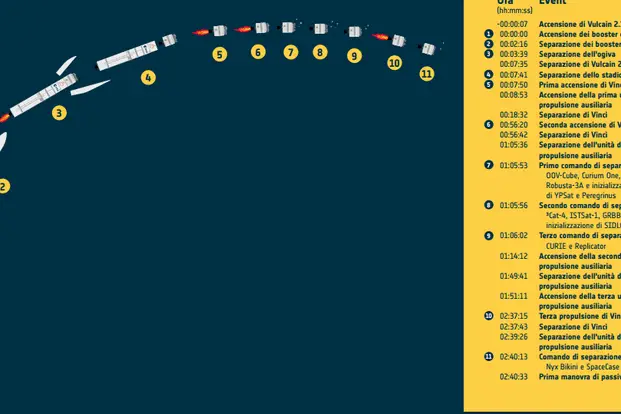The Ariane 6, the new launcher of the European Space Agency (ESA), already has a promising future ahead of it. With 29 planned missions, including 21 commercial ones, this launcher represents a significant breakthrough in the space sector. The majority of missions will therefore be dedicated to carrying satellites from private companies into orbit, underlining the importance of the role of private companies in space.
Stephane IsraelPresident and CEO of Arianespace, the company that manages launches from the European Space Centre in Kourou, said: “Thanks to Ariane 6, Europe has regained its autonomy in accessing space.” This launcher is not only a symbol of technological independence, but also an essential tool for commercial missions. In fact, of the 29 missions planned, 21 have been purchased by private companies.
Ariane 6: A Future of Intense Launches
Looking ahead, the pace of launches of theAriane 6 will be remarkable. The first commercial flight is scheduled for December of this year. In 2024, two flights are planned, followed by two more flights in March-April 2025. It is expected to reach 5 or 6 launches by the end of 2025, 8 launches in 2026 and, at full capacity, 9 launches per year.
ESA Director General, Josef Aschbachersaid: “In 2026, Ariane 6 will reach full capacity with 9 launches per year.” This ambitious goal reflects confidence in the launcher’s capabilities and the growing demand from the space market.
A launcher suitable for the Space Economy
The Ariane 6 stands out for its advanced technical features, which make it particularly suitable for the new Space Economy market. Available in two versions, one with two boosters and one with four, it is capable of carrying loads of up to 23 tons into low Earth orbit. Stephane Israel he stressed: “Ariane 6 is a powerful and modular launcher, perfect to meet the needs of the modern market”.
Despite a recent technical problem, the future of the Ariane 6 does not seem compromised. During the last mission, the upper stage engine, called Vinci, ignited only for a short time, failing to reach the planned orbit. However, Israel he reassured: “The maiden flight of Ariane 6 was a success, with most of the objectives achieved. The launch validated the main capabilities of the system, while the rest was a technology demonstration.”

Engine fault data expected soon
Data to clarify the causes of the Vinci engine malfunction are expected soon. Josef Aschbacher He said: “We will have the data in a few days, but analyzing it will take a week or two.” The engine fired successfully to release the first two sets of nanosatellites, but the third burn was too short, preventing the upper stage from reaching a lower orbit.
Aschbacher added:
“It is important to note that there were no problems during the main launch. The mission was a success and the nanosatellites were released correctly.”
Although the final phase of the trial has not been completed, the director general of theESA remains optimistic:
“Experimenting with a new technology in space also means dealing with possible failures. As soon as we have analyzed the data, we will make the necessary corrections.”
L’Ariane 6 It has thus proven to be a reliable and versatile launcher, ready to respond to the needs of a rapidly growing market. With an intense launch program and strong private sector participation, the future of European space looks bright.
What do you think about the growing role of private companies in space missions?
#Ariane #flights #booked #including #commercial #flights